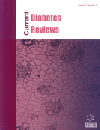- Home
- A-Z Publications
- Current Diabetes Reviews
- Previous Issues
- Volume 11, Issue 1, 2015
Current Diabetes Reviews - Volume 11, Issue 1, 2015
Volume 11, Issue 1, 2015
-
-
Pancreatic β-cell Glucose Toxicity in Type 2 Diabetes Mellitus
More LessPancreatic β-cells secrete insulin when blood glucose levels become high. However, when β-cells are chronically exposed to hyperglycemia, their function gradually deteriorates. Although such phenomena are called as β-cell glucose toxicity, its molecular mechanism remained unclear. This manuscript describes the possible mechanism for such β-cell dysfunction. In the diabetic state, nuclear expression levels of pancreatic tr Read More
-
-
-
Vitamin D Replacement and Type 2 Diabetes Mellitus
More LessAuthors: Claire. M. Issa, Mira S. Zantout and Sami T. AzarThe objective of this paper is to review the evidence testing the possible benefit of vitamin D replacement on diabetes control and complications. Type 2 diabetes mellitus (DM 2) has become a significant global health care problem and its reported incidence is increasing at an alarming rate. Despite the improvement in therapy and development of new drugs, treatment is still not optimal especially with the associated adverse Read More
-
-
-
Addressing Unmet Medical Needs in Type 2 Diabetes: A Narrative Review of Drugs under Development
More LessThe global burden of type 2 diabetes is increasing worldwide, and successful treatment of this disease needs constant provision of new drugs. Twelve classes of antidiabetic drugs are currently available, and many new drugs are under clinical development. These include compounds with known mechanisms of action but unique properties, such as once-weekly DPP4 inhibitors or oral insulin. They also include drugs with ne Read More
-
-
-
Carcinogenesis and Diabetic Wound Healing: Evidences of Parallelism
More LessAuthors: Kanhaiya Singh and Kiran SinghThere is a close association of chronic tissue damage, inflammation and cancer. A chronic injury may contribute to sustained healing response leading to fibrosis, organ failure and carcinogenesis. Wounds created due to mechanical or patho-physiological insults, generally follow a sophisticated series of mutually coherent steps leading to the re-establishment of the affected tissue or organ. The process of wound he Read More
-
-
-
The Pathogenic Role of Persistent Milk Signaling in mTORC1- and Milk- MicroRNA-Driven Type 2 Diabetes Mellitus
More LessMilk, the secretory product of the lactation genome, promotes growth of the newborn mammal. Milk delivers insulinotropic amino acids, thus maintains a molecular crosstalk with the pancreatic β-cell of the milk recipient. Homeostasis of β-cells and insulin production depend on the appropriate magnitude of mTORC1 signaling. mTORC1 is activated by branched-chain amino acids (BCAAs), glutamine, and palmitic acid Read More
-
Volumes & issues
-
Volume 21 (2025)
-
Volume 20 (2024)
-
Volume 19 (2023)
-
Volume 18 (2022)
-
Volume 17 (2021)
-
Volume 16 (2020)
-
Volume 15 (2019)
-
Volume 14 (2018)
-
Volume 13 (2017)
-
Volume 12 (2016)
-
Volume 11 (2015)
-
Volume 10 (2014)
-
Volume 9 (2013)
-
Volume 8 (2012)
-
Volume 7 (2011)
-
Volume 6 (2010)
-
Volume 5 (2009)
-
Volume 4 (2008)
-
Volume 3 (2007)
-
Volume 2 (2006)
-
Volume 1 (2005)
Most Read This Month
Article
content/journals/cdr
Journal
10
5
false
en


